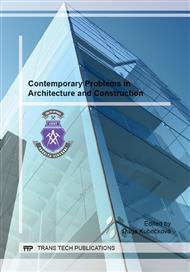[1]
Schubert, P., Hoffmann, G.: Druckfestigkeit von Mauerwerk parallel zu den Lagerfugen. Mauerwerk-Kalender 1994, Ernst Sohn & Berlin (2004).
DOI: 10.1002/dama.200490074
Google Scholar
[2]
Klusacek, L., Bazant, Z.: Structures Post-tensioning in Relation to Subsoil. The proceedings of the 13th International Seminary 2008, Ostrava 2008. VSB-TU Ostrava 2008, s. 21 – 26. ISBN 978-80-248-1715-6.
Google Scholar
[3]
Sulak, P.: Long–term Monitoring of Post-tensioned Structure. The proceedings of the 13th International Seminary 2008, Ostrava 2008. VSB-TU Ostrava 2008, s. 27 – 33. ISBN 978-80-248-1715-6.
Google Scholar
[4]
Terzijski, I., Klusacek, L., Kratochvil, M., Duchac, P., Volf, M., Pozar, M., Strnad, J., Bazant, Z.: Determination of Strain Properties of Masonry. Civil Engineering Journal, 2012, No. 1, pp.6-14. ISSN 1210- 4027.
Google Scholar
[5]
Cajka, R., Mateckova, P., Stara, M., Janulikova, M.: Testing of pre-stressed masonry corner for tri-axial stress-strain analysis. In Life-Cycle and Sustainability of Civil Infrastructure Systems - Proceedings of the 3rd International Symposium on Life-Cycle Civil Engineering, IALCCE 2012, Vienna, Austria, Pages 1955-1959, ISBN: 978-041562126-7.
DOI: 10.1201/b12995-8
Google Scholar
[6]
Cajka, R., Mateckova P.: Comparison of calculating methods and consequent carrying capacities of pre-stressed precast concrete roof purlin. First International Workshop "Design of Concrete Structures using EN 1992-1-1, Prague, 15 March 2010, ISBN 978-80-01-04581-7, WOS: 000324078100017CSN EN 1052-1 Methods of Test for Masonry, Part I, Determination of Compressive Strength, CEN Brussels (2000).
Google Scholar
[7]
CSN EN 1015-11 Methods of Test for Mortar for Masonry, Part 11: Determination of Flexural and Compressive Strength of Hardened Mortar, CEN Brussels (2000).
DOI: 10.3403/01905442
Google Scholar
[8]
CSN ISO 13822 Bases for design of structures - Assessment of existing structures. CEN Brussels (2005).
Google Scholar
[9]
CSN P ENV 1996-1-1 Design of masonry structures - Part 1-1: General rules for buildings - Rules for reinforced and unreinforced masonry. CEN Brussels (1996).
DOI: 10.3403/00873617
Google Scholar
[10]
CSN EN 1996-1-1 Design of masonry structures - Part 1-1: General rules for buildings - Rules for reinforced and unreinforced masonry. CEN Brussels (1996).
DOI: 10.3403/00873617
Google Scholar
[11]
Cajka, R.: Analysis of Stress in Half-space using Jacobian of Transformation and Gauss Numerical Integration. Advanced Materials Research, Vol. 818 (2013).
DOI: 10.4028/www.scientific.net/amr.818.178
Google Scholar
[12]
Stara, M., Janhulikova, M.: Laboratory measurements and numerical modeling of pre-stressed masonry, In Procedia Engineering, Volume 65 (2013), Pages 411-416, ISSN 1877-7058, doi: 10. 1016/j. proeng. 2013. 09. 064.
DOI: 10.1016/j.proeng.2013.09.064
Google Scholar
[13]
Cajka, R., Fojtik, R.: Development of Temperature and Stress during Foundation Slab Concreting of National Supercomputer Centre IT4. Procedia Engineering, Volume 65, 2013, Pages 230-235, ISSN 1877-7058, DOI: 10. 1016/j. proeng. 2013. 09. 035.
DOI: 10.1016/j.proeng.2013.09.035
Google Scholar
[14]
Cajka, R., Burkovic, K., Fojtik, R., Buchta, V.: Experimental Soil -Concrete Plate Interaction Test and Numerical Models. Key Engineering Materials, Vols. 577-578, (2014), pp.33-36, doi: 10. 4028/www. scientific. net/KEM. 577-578. 33.
DOI: 10.4028/www.scientific.net/kem.577-578.33
Google Scholar
[15]
Cajka, R., Labudkova, J.: Dependence of deformation of a plate on the subsoil in relation to the parameters of the 3D model. International Journal of Mechanics, 2014 (in print).
Google Scholar


